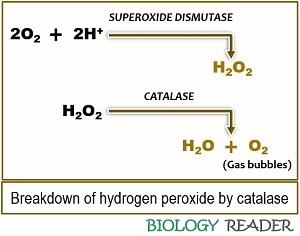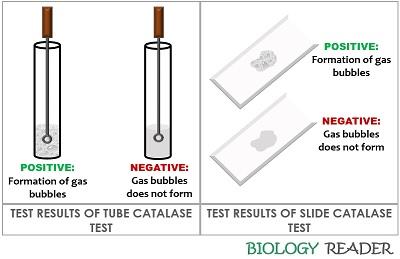Catalase test is one of the biochemical analysis that generally comes into use in identifying the organisms (whether they are catalase producers or not). It is primarily used to distinguish between the two classes of gram-positive bacteria, namely Staphylococcus and Streptococcus species.
Streptococcus bacteria are mostly facultative anaerobes (may produce catalase), while few are obligate anaerobes (cannot produce catalase). Staphylococcus bacteria are aerobic and contain catalase enzyme to break down the reactive oxygen forms like superoxide and hydrogen peroxide.
Thus, catalase functions as an antioxidant that breakdown the toxic oxygen reactive species inside a cell to produce non-toxic products like H2O and O2.
In this context, we will discuss the definition, principle, preparation of the test reagent and the two common methods (tube and slide test) of the catalase test. You would also come to know the examples of catalase-positive and catalase-negative organisms as well as the uses and limitation of the catalase test.
Content: Catalase Test
Definition
A catalase test refers to a biochemical analysis of microorganisms that generally discriminates the two different forms of bacteria, namely aerobic and anaerobic, based on the oxygen requirement. Aerobic bacteria require oxygen for their growth, and they metabolize oxygen into many reactive oxygen species, like superoxide anion, peroxides, hydroxyl radicals etc.
The reactive oxygen species within the cells can lead to oxidative damage in the intercellular contents (cell organelles, DNA etc.). The organisms possess catalase enzyme, which can grow in an oxygen-rich environment. Catalase protects the microorganisms from oxidative stress by the oxygen reactive forms.
Anaerobic bacteria include two sub-groups, like facultative and strict anaerobes. Facultative anaerobes can grow in the presence or absence of oxygen, and they may also contain catalase enzyme, whereas obligate anaerobes lack such enzyme.
Overview of Catalase Test
Before moving into the theory of the catalase test, we must be aware of specific terms that we will go through in this article.
Catalase
It is an enzyme that is ubiquitous or present in almost all living organisms. Catalase enzyme belongs to the class of “Peroxidases” that functions as an antioxidant agent. It comprises four polypeptide chains, which splits the toxic hydrogen peroxide into non-toxic oxygen and water. Thus, a catalase enzyme works as a detoxifying agent by defending a cell in counter to the oxidative damage by hydrogen peroxide.
Hydrogen peroxide
It is a toxic by-product, which forms as an outcome of cellular respiration. The peroxide ion or H2O2 acts as a strong oxidizer, which oxidizes protein, membrane lipids etc., that ultimately causes cell apoptosis or death (if not removed quickly). Superoxide plus hydrogen ion forms hydrogen peroxide via the enzymatic activity of superoxide dismutase.
Principle of Catalase Test
The principle of the catalase test is based on the rapid detection of catalase presence, which becomes evident by the formation of copious gas bubbles. Catalase positive organisms can detoxify the toxic effect of H2O2 by the catalytic activity of catalase.

Oppositely, catalase-negative microorganisms cannot decompose H2O2 as they lack catalase. The catalase test involves the mixing of inoculum with hydrogen peroxide. If the test organisms contain catalase, they can easily degrade H2O2 into H2O and O2 (in the form of bubbles). There will be no formation of gas bubbles if a test organism lacks catalase.
Test Reagent
The catalase test only uses a single reagent (hydrogen peroxide). 3% of hydrogen peroxide is needed to check the presence of catalase in aerobically cultured bacteria. 15% of hydrogen peroxide is required to check the presence of catalase in an anaerobically cultured test organism.
- To prepare a 3% solution of H2O2: Dissolve 3 grams of hydrogen peroxide in 100 ml of distilled water.
- Similarly, for the preparation of a 15% solution of H2O2: Dissolve 15 grams of hydrogen peroxide in 100 ml of distilled water.
Procedure
The catalase test can be performed by two standard methods, namely the tube and slide method.
Tube Method
It involves the following sequential steps:
- First, sterilize the test tubes by either using an autoclave or a hot air oven.
- Then, pour 1-3 ml of hydrogen peroxide into the tubes under sterile conditions.
- After that, take 24 hours of bacterial inoculum via a sterilized inoculating loop.
- Dip the inoculating loop straight into the test tube containing H2O2
- Observe the tubes for instant bubbling.
Slide Method
It involves the following sequential steps:
- First, sterilize glass slides by either using an autoclave or a hot air oven.
- Then, take 24 hours old bacterial inoculum via a sterilized inoculating loop under sterile conditions.
- Prepare a bacterial smear over the glass slide.
- Add 1-2 drops of H2O2 to the top of the bacterial smear.
- Observe the glass slide for the formation of bubbles.
Test Results
Positive result: Formation of effervescences or copious gas bubbles occurs.
Example: Corynebacterium diphtheria, mycobacterium tuberculosis, Rhodococcus equi, Staphylococcus sp, Listeria sp etc.
Negative result: There will be no formation of oxygen bubbles.
Example: Streptococcus sp, Enterococcus sp etc.

Uses of Catalase Test
- The catalase test marks the existence of the catalase enzyme in the microbial sample.
- It differentiates the catalase-positive and catalase-negative organisms relative to their genera as well as speciation.
- It also uses as a possible method in identifying and differentiating different organisms belonging to the Enterobacteriaceae family.
- The catalase test also distinguishes between the aerobic and obligate anaerobic bacteria based on the production of catalase enzyme.
- It also differentiates between the aerotolerant strains of Clostridium sp (non-catalase producers) from the Bacillus sp (catalase producers).
Limitations of Catalase Test
- To perform a catalase test, a test organism incubated for 18 to 24 hours should be used.
- Hydrogen peroxide should be freshly prepared to perform the experiment, as it is a volatile compound.
- Test organism inoculated from the blood agar media frequently gives false-positive results, as the RBCs are catalase-positive cells.
Therefore, the catalase test is a prevalent method to differentiate between different groups (aerobic and anaerobic), species based on the production of catalase enzyme.
Short, precise and very clear. thank you!